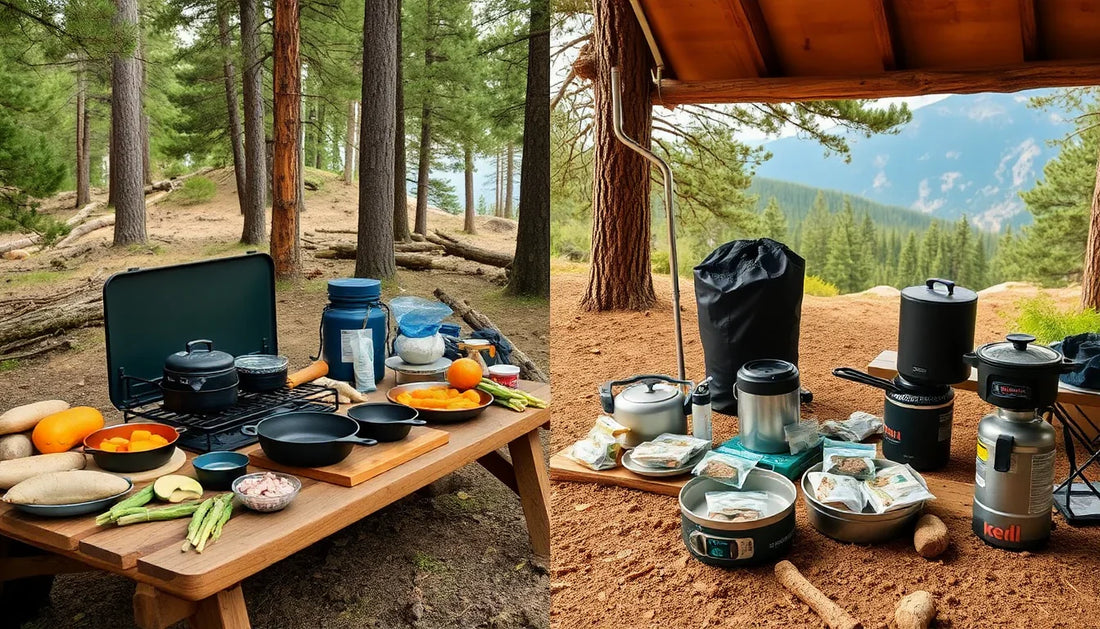
Campground Cooking vs Backpacking Meals: What's the Difference?
Share
When it comes to outdoor adventures, the food you choose to bring can make a significant difference in your overall experience. Whether you're planning a cozy campground getaway or an ambitious backpacking trip, understanding the distinctions between campground cooking and backpacking meals is crucial. In this blog post, we'll explore the key differences and provide tips to help you make the most of your outdoor culinary adventures.
Campground Cooking: Comfort and Convenience
Campground cooking is all about embracing the comforts of home in the great outdoors. With access to a vehicle and the ability to bring more gear, campground cooking offers a wider range of options and a more relaxed approach to meal preparation.
Equipment and Setup
Campground cooking typically involves larger, more robust cooking equipment, such as camp stoves, griddles, and even portable ovens. The setup can be more elaborate, with dedicated cooking areas, tables, and even outdoor kitchens. This allows for more versatile meal preparation and the ability to cook a wider variety of dishes.
Food Storage and Preservation
Campground cooking provides more opportunities for food storage and preservation. You can bring coolers, ice chests, and even small refrigerators to keep perishable items fresh. This opens up the possibility of using fresh, locally sourced ingredients and preparing meals that require more complex preparation.
Meal Preparation Techniques
Campground cooking allows for a more relaxed and varied approach to meal preparation. You can use a wider range of cooking methods, such as grilling, sautéing, and even baking, to create more elaborate and satisfying dishes.
Pros and Cons
The main advantages of campground cooking include the ability to prepare more diverse and comforting meals, the convenience of having more equipment and storage options, and the opportunity to enjoy the outdoor experience with a touch of home-like comfort. However, the trade-off is the increased weight and space requirements, which can limit your mobility and exploration.
Backpacking Meals: Lightweight and Efficient
Backpacking meals, on the other hand, are designed with a focus on weight, portability, and ease of preparation. The goal is to minimize the burden on your back while still providing the necessary nutrition and sustenance for your adventures.
Weight and Portability Considerations
When it comes to backpacking, every ounce counts. Backpacking meals are typically lightweight, compact, and easy to transport. This often means relying on dehydrated, freeze-dried, or shelf-stable ingredients that can be quickly rehydrated or prepared with minimal effort.
Meal Types and Preparation
Backpacking meals often come in the form of pre-packaged, ready-to-eat meals or meal kits that require minimal preparation. This can include things like instant oatmeal, energy bars, and freeze-dried entrees that only require the addition of hot water.
Nutritional Requirements
Backpacking requires a different approach to nutrition. Meals need to be calorie-dense, nutrient-rich, and easy to digest, providing the necessary energy and sustenance for the physical demands of hiking and exploring.
Pros and Cons
The main advantages of backpacking meals include their lightweight and compact nature, which allows for greater mobility and exploration. They also offer convenience and simplicity in preparation, which can be especially valuable after a long day on the trail. However, the trade-off is a more limited range of meal options and the potential for a less satisfying culinary experience.
Key Differences
The key differences between campground cooking and backpacking meals can be summarized as follows:
Equipment
Campground cooking typically involves larger, more robust cooking equipment, while backpacking meals focus on lightweight, portable options.
Food Choices
Campground cooking allows for a wider range of fresh, perishable ingredients, while backpacking meals rely more on dehydrated, shelf-stable, and calorie-dense options.
Preparation Methods
Campground cooking offers more versatile preparation techniques, such as grilling, sautéing, and baking, while backpacking meals often require simple rehydration or minimal effort.
Weight and Storage
Campground cooking allows for more weight and storage capacity, while backpacking meals prioritize lightweight and compact design.
Tips for Successful Outdoor Meal Planning
Whether you're planning a campground getaway or a backpacking adventure, here are some tips to help you make the most of your outdoor culinary experiences:
Campground Cooking Strategies
- Invest in quality, versatile cooking equipment to expand your meal options.
- Prioritize fresh, locally sourced ingredients and plan meals that take advantage of your campground setup.
- Experiment with different cooking techniques and recipes to create memorable outdoor meals.
Backpacking Meal Optimization
- Choose lightweight, calorie-dense, and easy-to-prepare meals that align with your nutritional needs.
- Opt for dehydrated or freeze-dried ingredients that can be quickly rehydrated on the trail.
- Plan your meals in advance and consider pre-portioning ingredients to save time and weight.
Essential Gear Recommendations
- For campground cooking, consider a portable camp stove, a sturdy cooler, and a set of durable cookware.
- For backpacking, prioritize lightweight, compact options like a backpacking stove, a titanium pot, and a water filter.
Conclusion
Campground cooking and backpacking meals represent two distinct approaches to outdoor culinary experiences. By understanding the key differences in equipment, food choices, preparation methods, and weight considerations, you can make informed decisions that align with your outdoor adventure goals and preferences. Whether you're seeking the comforts of home in the great outdoors or the challenge of lightweight, efficient backpacking, this guide will help you make the most of your next outdoor culinary adventure.
